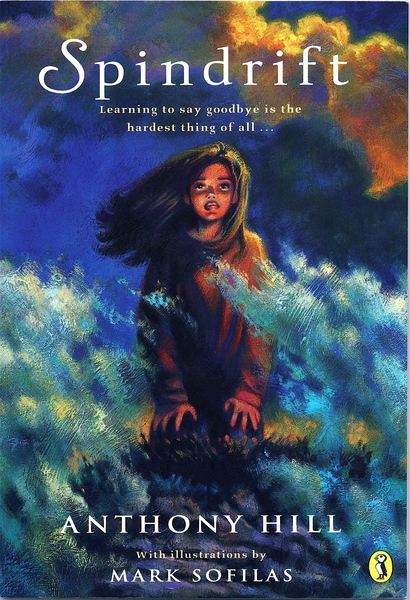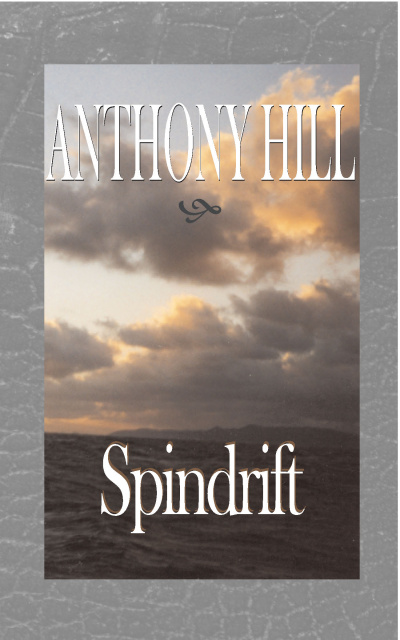|
Spindrift
Spindrift by Anthony Hill, illustrated by Mark Sofilas. Puffin, 1996, 80 pages, paperback.
Spindrift is currently out of print. Buy eBook $3.95
 In whole, it is an exquisite miniature, capturing a small moment in time with great skill, artistry and finesse (Reading Time). In whole, it is an exquisite miniature, capturing a small moment in time with great skill, artistry and finesse (Reading Time).
Anthony Hill's third book for young readers also deals with another difficult subject: the experience of death and the need for all of us to come to terms with it. Again illustrated again by Mark Sofilas, it was a Notable Book in the Children's Book Council of Australia 1997 Awards.
Elizabeth is standing by the angry sea. Watching. Waiting for the dolphins.
Elizabeth, and the gulls are crying, and the bitter wind is catching the white foaming tops of the breaking waves, tossing them high and throwing a curtain of sea spray - a veil of fine blowing spindrift - across the wild shore.
Watching. Waiting for the dolphins, to whom Elizabeth will give the spirit of her grandmother, dying of cancer in the house on the cliff top. It is thus that she meets the old beachcomber, 'Bull' Morgan. The simple story shows how, over the next few days, these two very different people share the pain of loss, and grow towards friendship and an understanding of each other. Elizabeth learns something of Morgan's unhappy past and the ways of the sea - as he learns from the girl a capacity to let loved ones go.
What the critics said about Spindrift.
The sparse, poetic text captures the solemnity of the dying process (Cathryn Crowe).
In this book about loss and grieving, beautiful language and a scatter of black and white drawings maintain the flow of emotions, and enhance a sensitive but unsentimental attitude to death (CBCA).
The original cover for Spindrift by Mark Sofilas
The elemental mystery of life and death is heightened by playing the story out against a naturally profound grand backdrop, here a wind-charged sea and sky (Magpies Magazine).
An excellent resource to read aloud to middle and upper primary students, and to support Health topics dealing with death and dying and family relationships (Fiction Focus).
About the illustrations:
As The Burnt Stick introduced Anthony Hill as a children's writer of merit, it also marked the debut of Mark Sofilas as an illustrator of children's books. He is remarkably talented. Again he has chosen graphite pencil and charcoal to highlight moments of action and emotion. The poignancy and solitude of personal grief is exquisitely captured. Illustration is liberally interspersed amongst the text in the form of little vignettes... They give the book a special quality that enhances the grandeur of the theme (Magpies).
What gave you the idea to write Spindrift?
Stories have their beginnings in all kinds of things. Spindrift was in part inspired by a powerful dream somebody once told me - of dolphins and a strange little creature crawling out of the sea. It is to a large extent a response to the time I spent with my own grandmother during the last few days of her life: a deeply spiritual, emotional and loving experience. The scenery was drawn from a trip I made during stormy weather along the Great Ocean Road of southern Victoria in the early 1990s.
But the story was triggered by the word Spindrift itself. I came across it in a history book which talked about 'the spindrift of the past'. I thought, What a marvellous word, what a great title for a book - what does it mean? I looked it up in the dictionary, and the whole association of ideas flowed from that.
Why did you call the beachcomber 'Bull' Morgan?

In my books, the names of the main characters all have meaning for the story. Elizabeth, for instance, is not only my own mother's name, it is from the Hebrew word meaning 'oath of God.' The beachcomber's proper name is Kerry Morgan. They are Celtic words meaning 'dark one from the sea.'
The cover for the eBook version of Spindrift designed by Denis French
Hidden away in the story are references to the Roman god of the sea, Neptune, to whom white horses were sacrificed and also black bulls. We still sometimes call the breaking waves 'white horses', and the Spanish bullfights derive from the ancient cult of the sea god. In the story, Morgan's wife, Ruth, is sacrificed to the sea ... as he in turn releases the little creature that has come to Elizabeth and himself from the waves.
The strange, elemental life that had come to him out of the sea: why had he not taken it? And kept it? And turned it into cold, hard cash.
'Could a been set up for good,' Bull Morgan muttered.
Why, then, had he done as the girl pleaded and let it go? What madness had possessed him to sacrifice that?
'Ruthie,' Kerry Morgan said to himself. 'Ruthie...'
And in that moment, through the spindrift of his own tears, he wondered if he had begun to let her go as well.
What does the end of the story mean?
There is more than one meaning to any story, as the old man remarks in The Burnt Stick. Different people see different things in the tale, and their interpretations can be just as true.
I saw the creature at the end of Spindrift as an image of new life crawling out of the great sea of humanity. It is an affirmation of the beauty and wonder of existence, however mis-shapen it may at first appear to be. But an eight-year-old pupil wrote me a letter turning that imagery on its head. He saw the creature as Morgan's hate coming out of the water and the beachcomber at last letting it go. I hadn't thought of that, but of course it is a very valid reading.
Authors rarely understand the full implications of their work. The great joy of writing is to be able to share this business of discovery with your readers.
|